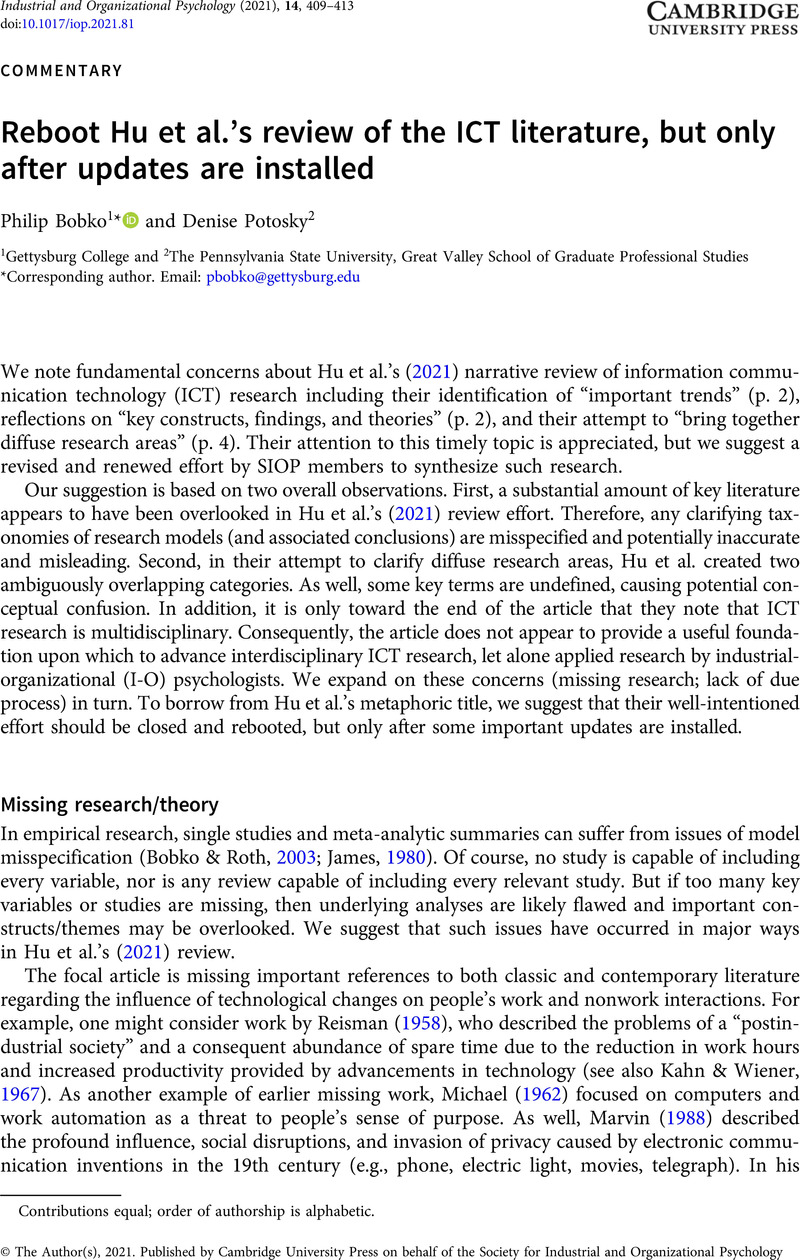No CrossRef data available.
Article contents
Reboot Hu et al.’s review of the ICT literature, but only after updates are installed
Published online by Cambridge University Press: 22 September 2021
Abstract
An abstract is not available for this content so a preview has been provided. Please use the Get access link above for information on how to access this content.

- Type
- Commentaries
- Information
- Copyright
- © The Author(s), 2021. Published by Cambridge University Press on behalf of the Society for Industrial and Organizational Psychology
Footnotes
Contributions equal; order of authorship is alphabetic.
References
Barnlund, D. C. (1970). A transactional model of communication. In Akin, J., Goldberg, A., Myers, G., & Stewart, J. (Eds.), Language behavior: A book of readings in communication (pp. 43–61). Mouton.CrossRefGoogle Scholar
Bobko, P., & Roth, P. (2003). Meta-analysis and validity generalization as research tools: Issues of sample bias and degrees of mis-specification. In Murphy, K. (Ed.), Validity generalization: A critical review (pp. 67–90). Lawrence Erlbaum Associates.Google Scholar
Edgerton, D. (1999). From innovation to use: Ten eclectic theses on the historiography of technology. History and Technology, an International Journal, 16(2), 111–136.CrossRefGoogle Scholar
Garrett, R. K., & Danziger, J. N. (2007). IM= Interruption management? Instant messaging and disruption in the workplace. Journal of Computer-Mediated Communication, 13(1), 23–42.CrossRefGoogle Scholar
Grandhi, S. A., & Jones, Q. (2015). Knock, knock! Who’s there? Putting the user in control of managing interruptions. International Journal of Human-Computer Studies, 79, 35–50.CrossRefGoogle Scholar
Grudin, J. (1994). Computer-supported cooperative work: History and focus. Computer, 27(5), 19–26.CrossRefGoogle Scholar
Hu, X., Barber, L., Park, Y., & Day, A. (2021). Defrag and reboot? Consolidating information and communication technology research in I-O psychology. Industrial and Organizational Psychology: Perspectives on Science and Practice, 14(3), 371–396.Google Scholar
Jackson, T., Dawson, R., & Wilson, D. (2003). Reducing the effect of email interruptions on employees. International Journal of Information Management, 23, 55–65.CrossRefGoogle Scholar
James, L. (1980). The unmeasured variables problem in path analysis. Journal of Applied Psychology, 65, 415–421.CrossRefGoogle Scholar
Jones, R. (2013). The communication process. Communication in the real world: An introduction to communication studies, Chapter 1.2. The Saylor Foundation. https://open.lib.umn.edu/communication/
Google Scholar
Kahn, H., & Wiener, A. J. (1967). The Year 2000: A framework for speculation on the next thirty-three years. Macmillan.Google Scholar
Kirkman, B. L., Gibson, C. B., & Kim, K. (2012). Across borders and technologies: Advancements in virtual teams research. In Kozlowski, S. W. J. (Ed.), The Oxford handbook of organizational psychology (Vol. 2, pp. 789–858). Oxford University Press.Google Scholar
Leonardi, P. M. (2012). Materiality, sociomateriality, and socio-technical systems: What do these terms mean? How are they related? Do we need them? In Leonardi, P. M., Nardi, B. A., & Kallinikos, J. (Eds.), Materiality and organizing: Social interaction in a technological world (pp. 25–48). Oxford University Press.CrossRefGoogle Scholar
Marvin, C. (1988). When old technologies were new: Thinking about electric communication in the late nineteenth century. Oxford University Press.Google Scholar
Mathieu, J., Wolfson, M., & Park, S. (2018). The evolution of work team research since Hawthorne. American Psychologist, 73, 308–321.CrossRefGoogle ScholarPubMed
McDaniel, S., Salas, E., & Kazak, A. (Eds.). (2018). The science of teamwork [Special issue]. American Psychologist, 73.CrossRefGoogle Scholar
Michael, D. N. (1962). Cybernation: The silent conquest. Center for the Study of Democratic Institutions.Google Scholar
Morelli, N., Potosky, D., Arthur, W., & Tippins, N. (2017). A call for conceptual models of technology in I-O psychology: An example from talent-based technology assessment. Industrial and Organizational Psychology: Perspectives on Science and Practice, 10(4), 634–653.CrossRefGoogle Scholar
Orlikowski, W. J. (2007). Sociomaterial practices: Exploring technology at work. Organization Studies, 28, 1435–1448.CrossRefGoogle Scholar
Pearce, J., & Huang, L. (2012). Toward an understanding of what actionable research is. Academy of Management Learning & Education, 11, 300–301.CrossRefGoogle Scholar
Potosky, D. (2008). A conceptual framework for the role of the administration medium in the personnel assessment process. Academy of Management Review, 33, 629–648.CrossRefGoogle Scholar
Puranik, H., Koopman, J., & Vough, H. C. (2020). Pardon the interruption: An integrative review and future research agenda for research on work interruptions. Journal of Management, 46(6), 806–842.CrossRefGoogle Scholar
Putnam, L. L., & Nicotera, A. M. (2010). Communicative constitution of organization is a question: Critical issues for addressing it. Management Communication Quarterly, 24(1), 158–165.CrossRefGoogle Scholar
Reisman, D. (1958). Work and leisure in post-industrial society. In Larrabee, E. & Meyersohn, R. (Eds.), Mass leisure (pp. 363–385). Free Press.Google Scholar
Rice, R., & Leonardi, P. (2013). Information and communication technologies in organizations. In Putnam, L. L. & Mumby, D. K. (Eds.), The SAGE handbook of organizational communication (pp. 425–448). Sage.Google Scholar
Shannon, C. E., & Weaver, W. (1949). The mathematical theory of communication. The University of Illinois.Google Scholar
Stewart, A. E., Vrzakova, H., Sun, C., Yonehiro, J., Stone, C. A., Duran, N. D., Shute, V., & D’Mello, S. K. (2019). I say, you say, we say: Using spoken language to model socio-cognitive processes during computer-supported collaborative problem solving. Proceedings of the ACM on Human-Computer Interaction, 3(CSCW), Article 194.CrossRefGoogle Scholar
Wajcman, J., & Rose, E. (2011). Constant connectivity: Rethinking interruptions at work. Organization Studies, 32(7), 941–961.CrossRefGoogle Scholar


